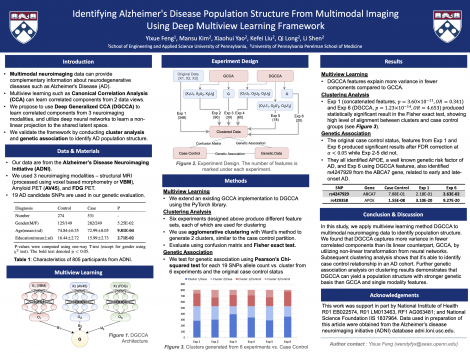Yixue Feng
Identifying Alzheimer's Disease Population Structure From Multimodal Imaging Using Deep Multiview Learning Framework
Abstract
Different modalities of neuroimaging data can provide complementary information about neurodegenerative diseases such as Alzheimer's Disease (AD). In this study, we propose to use multiview learning method - Deep Generalized Canonical Correlation Analysis (DGCCA) to learn correlated components from multimodal imaging data. DGCCA can project multiview features to a latent space by applying non-linear transformation using neural networks and is able to explain more variance than it's linear counterpart, Generalized Canonical Correlation Analysis (GCCA), with low dimensionality. Subsequent clustering analysis on the learned components from DGCCA shows that it's able to identify population structure - namely case control relationship in an AD cohort. Further genetic association analysis on clustering results demonstrates that DGCCA can yield a population structure with stronger genetic basis than GCCA and single modality features.
Keywords
Alzheimer's Disease, deep learning, multiview learning, multimodal imaging, canonical correlation analysisCommenting is now closed.
About Us
To understand health and disease today, we need new thinking and novel science —the kind we create when multiple disciplines work together from the ground up. That is why this department has put forward a bold vision in population-health science: a single academic home for biostatistics, epidemiology and informatics.
© 2023 Trustees of the University of Pennsylvania. All rights reserved.. | Disclaimer




Comments